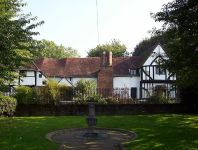Walton-on-Thames is a market town on the south bank of the Thames in the Elmbridge borough of Surrey, England. The town itself consists mostly of affluent suburban streets, with a historic town centre of Celtic origin. It is one of the largest towns in the Elmbridge borough, alongside Weybridge. According to the 2011 Census, the town has a total population of 22,834. It is around 15 miles from Central London, and is served by a wide range of transport links.
History
The name "Walton" is Anglo-Saxon in origin and is cognate with the common phonetic combination meaning "Briton settlement" (literally, "Welsh Town" – weal(as) tun). Before the Romans and the Saxons were present, a Celtic settlement was here. The most common Old English word for the Celtic inhabitants was the "Wealas", originally meaning "foreigners" or "strangers".William Camden identified Cowey Stakes or Sale, Walton as the place where Julius Caesar forded the River Thames on his second invasion of Britain. A fisherman removed several wooden stakes about thigh-width and 6 feet (1.8 m) high that were very black and hard enough to turn an axe, and shod with iron. He sold these to John Montagu, 5th Earl of Sandwich, who used to come to the neighbouring Shepperton bank to fish, for half a guinea apiece. Elmbridge Museum requires definitive evidence of these stakes, the evidence at present limited to pre 20th-century secondary sources that conflict as to detail.
Walton lay within the Anglo-Saxon district of Elmbridge hundred, in the shire (later county) of Surrey.
Walton appears in the Domesday Book of 1086 as "Waletona". The settlement was held jointly as overlords in the feudal system by Edward de Sarisber (Salisbury) and Richard de Tonbrige. Its Domesday assets were: 6 hides; 1 church (St. Mary's), 2 mills worth £1 5s 0d, 1 fishery worth 5s, 14 ploughs, 40 acres (16 ha) of meadow, supporting 50 hogs. It rendered £28.
The nucleus of the village is in the north, while later development took place in the so
